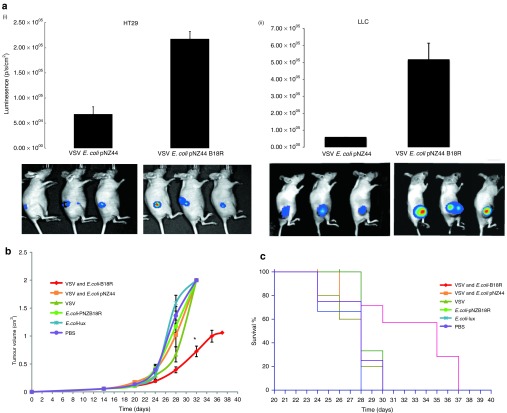Figure 5.
E. coli–B18R increases oncolytic virus replication and tumor destruction in vivo. HT29 or LLC subcutaneous tumors were raised in athymic mice. E. colicontaining either an empty vector (pNZ44) or the therapeutic B18R plasmid were administered IV at 106 cfu in 100 µl. One week after bacterial administration, 107 pfu VSVΔ51FLuc were injected IV, and VSVΔ51FLuc luminescence measured by BioLuminescence Imaging (BLI) intermittently, (a) VSV-related luminescence measurements and representative images from (i) HT29 or (ii) LLC xenograft bearing mice in the absence or presence of bacterial B18R expression. Representative data shown relate to 40 hours after VSV administration. (b) LLC tumor growth over time. *Significant difference in tumor volumes at day 32 (P < 0.05). (c) Kaplan–Meier survival curves for LLC-bearing athymic mice treated with (i) E. coli–B18R plus VSVΔ51FLuc (combination treatment, red), (ii) E. coli pNZ44 plus VSVΔ51FLuc (backbone E. coli vector plus VSV, orange), (iii) VSVΔ51FLuc alone (dark green), (iv) E. coli–B18R alone (bright green), (v) E. coli–lux (reporter strain, blue), or (vi) PBS (untreated, purple). Survival was significantly prolonged by E. coli–B18R, with mean survival of the E. coli–B18R plus VSVΔ51FLuc group significantly higher than any of the other groups (P < 0.0211). LLC, Lewis lung carcinoma; VSV, vesicular stomatitis virus.

